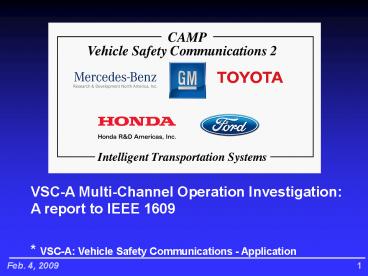CICAS-V Progress Briefing PowerPoint PPT Presentation
1 / 19
Title: CICAS-V Progress Briefing
1
VSC-A Multi-Channel Operation Investigation A
report to IEEE 1609 VSC-A Vehicle Safety
Communications - Application
2
VSC-A Project Statement of Work
- Subtask 5.2.6 Channel 172 Usage
- In light of the recent FCC memorandum
designating DSRC channel 172 exclusively for
vehicle-to-vehicle safety communication the
VSC-A team proposes to study methods for
optimizing the use of channel 172 for VSC-A
applications. An analysis will be conducted to
determine potential approaches . This analysis
will also take into account the current and
related activities (channel switching) in IEEE
1609.4. VSC-A team to determine and recommend
an optimal usage approach for this channel.
(emphasis added)
3
FCC Memorandum Opinion and OrderJuly 26, 2006
(FCC 06-110)
- We designate Channel 172 (frequencies
5.855-5.865 GHz) exclusively for
vehicle-to-vehicle safety communications for
accident avoidance and mitigation, and safety of
life and property applications - we agree that vehicle-to-vehicle collision
avoidance and mitigation applications are
exceptionally time-sensitive and should not be
conducted on potentially congested channels. - the delay associated with shared use of a
time-critical DRSC channel could be literally
life-threatening in the context of collision
avoidance
4
VSC-A Multi-Channel Work
- Two pronged study
- Quantitative analysis of 1609.4 50/50 Channel
Switching performance not part of this
presentation - Consideration of alternative approaches
- Includes qualitative comparison with 1609.4
5
Constraints applied to alternatives (initial
study)
- Single-radio must be sufficient for safety
second radio may optionally be deployed.
Dual-radio deployments assume they co-exist with
single-radio deployments - No additional over-the-air protocol information
- Each vehicle attempts to hear all safety messages
6
Criteria for evaluating Multi-Channel scenarios
- How well does single radio support safety
applications and non-safety applications? - Does optional second radio provide demonstrable
benefit? - Is channel 172 used for V-V Safety
communications? - Criteria importance not assumed equal criteria
are subjective
7
Taxonomy of Channel Switching Scenarios
Safety on CCH
Safety on Ch. 172
1609.4
Always-on Safety Channel
Always-on Safety Channel
3-way switch
1 radio
2 radios
1 radio
2 radios
1 radio
2 radios
2 radios
1 radio
8
Taxonomy of Channel Switching Scenarios
Safety on CCH
Safety on Ch. 172
1609.4
Always-on Safety Channel
Always-on Safety Channel
3-way switch
1 radio
2 radios
1 radio
2 radios
1 radio
2 radios
2 radios
1 radio
Defer
Focus
Focus
Will not pursue further
9
Taxonomy of Channel Switching Scenarios
Safety on CCH
Safety on Ch. 172
1609.4
Always-on Safety Channel
Always-on Safety Channel
3-way switch
1 radio
2 radios
1 radio
2 radios
1 radio
2 radios
2 radios
1 radio
Good Initial Deployment
Long Term Advantages
10
Taxonomy of Channel Switching Scenarios
Safety on CCH
Safety on Ch. 172
1609.4
Always-on Safety Channel
Always-on Safety Channel
3-way switch
1 radio
2 radios
1 radio
2 radios
1 radio
2 radios
2 radios
1 radio
No Obvious Migration Path
Good Initial Deployment
Long Term Advantages
11
Spectrum and Time Usage Maps1609.4, single and
dual radio cases
- Spectrum Map
Radio 1
Radio 2 optional
Time Map
12
Spectrum and Time Usage Mapsalways-on Ch 172,
single and dual radio cases
- Spectrum Map
Radio 1
Radio 2 optional
Time Map
13
Qualitative Comparison
- 1609.4 single-radio has broad functionality
- 1609.4 single-radio capacity for safety very
limited - 1609.4 dual-radio does not add much capability
- Ch 172 single-radio has 2x capacity for safety
- Ch 172 single-radio does not support control or
non-safety - Ch 172 dual-radio has attractive trade-off
between safety capacity and non-safety support - No obvious migration between 1609.4 single-radio
and Ch 172 dual-radio
14
Reconsider constraints applied to alternatives
ongoing study
Keep This
- Single-radio must be sufficient for safety
second radio may optionally be deployed and
assumes it co-exists with single-radio
deployments - No additional over-the-air protocol information
- Each vehicle attempts to hear all safety messages
Relax This
Keep This but single-radio and dual-radio have
different capabilities
15
Basic Idea Provide migration path
- Add information to WSM header reporting senders
multi-channel intent/capability - Simplest case 1-bit indicates if sender is
single-radio - More sophisticated cases possible as well
- Dual-radio vehicle monitors neighbors
- Adapts behavior based on presence/absence of
single-radio neighbors - Simplest case if at least one single-radio
neighbor, revert to 1609.4, else use always-on
safety channel
16
Case 1 At least one single-radio car in
neighborhood indicates limited capability
Heartbeat, with WSM header bit indicating
enhanced capability
target car
Heartbeat, with WSM header bit indicating limited
capability
Single-radio vehicle
- If at least one car in neighborhood sends packets
with bit indicating limited capability, target
car (center) sends heartbeat during CCH interval
in CCH
SCH interval
CCH interval
17
Case 2 all cars have enhanced capability
Heartbeat, with WSM header bit indicating
enhanced capability
target car
- If all cars in neighborhood have enhanced
capability, target car (center) free to send
heartbeat anytime in safety channel
SCH interval
CCH interval
18
Basic Idea Provide migration path
- VSC-A considering several flavors of this
approach - Goal is to provide single-radio vehicles with
best safety that 1609.4 can support - Provide dual-radio vehicles with more access to
safety information, using extra capacity not
available to single-radio vehicles during times
of congestion - Header information can also be used to indicate
intent to access a service - This idea makes most sense if, eventually, most
vehicles have enhanced capability (i.e.
dual-radios)
19
VSC-A next steps
- Continue exploring alternatives
- Simulation study to determine performance of
candidates - Implement in vehicle testbed to prove feasibility
- Dialog with IEEE 1609.4
- Select preferred approach based on technical and
policy evaluation

